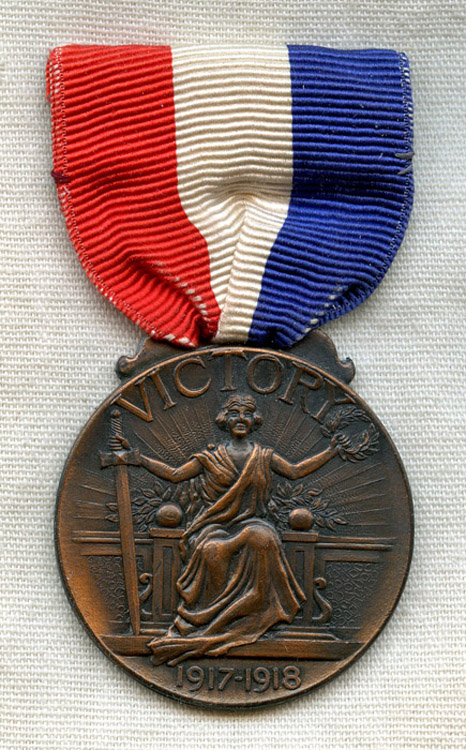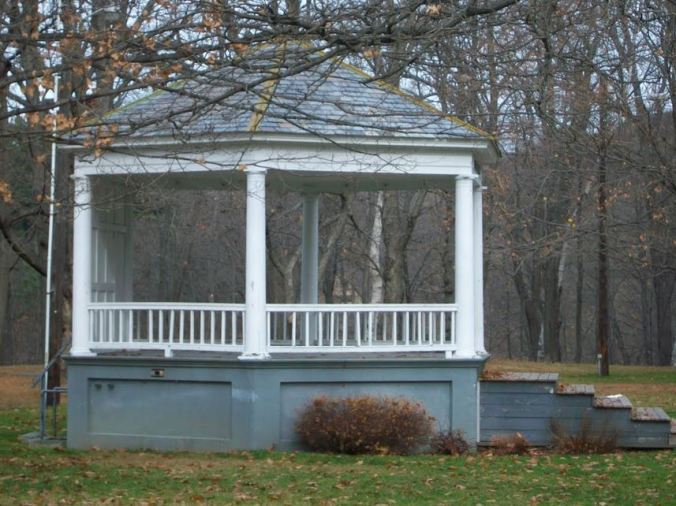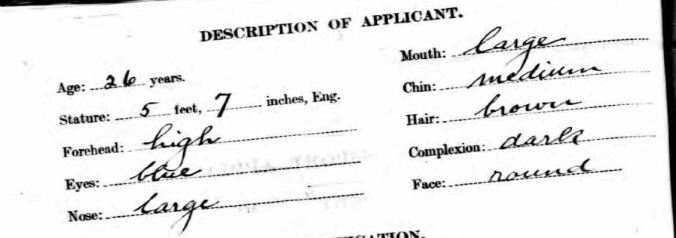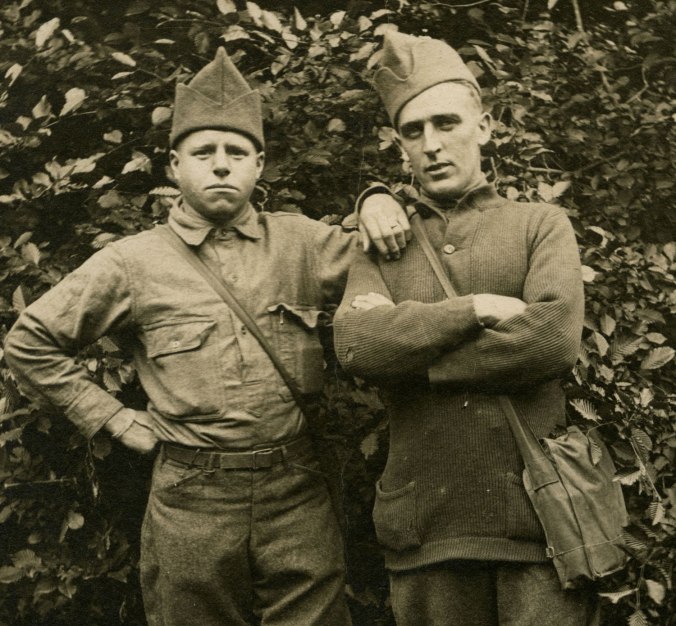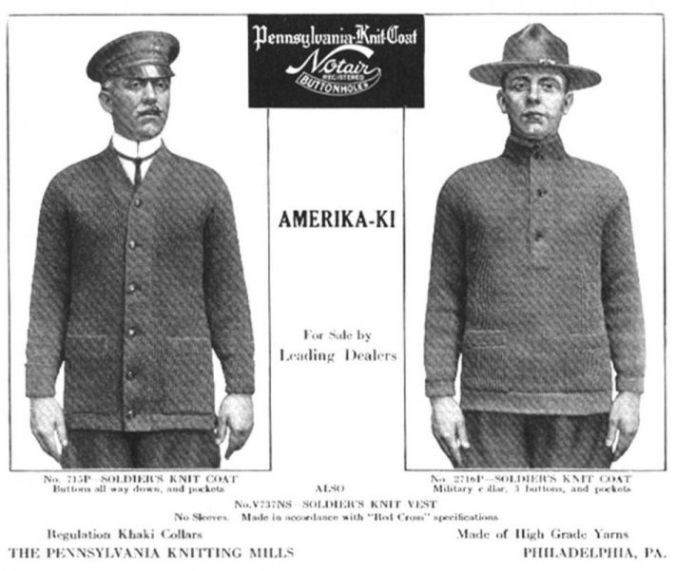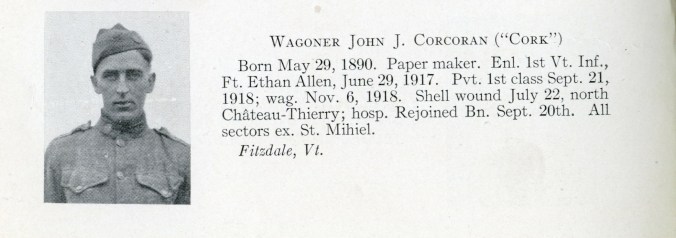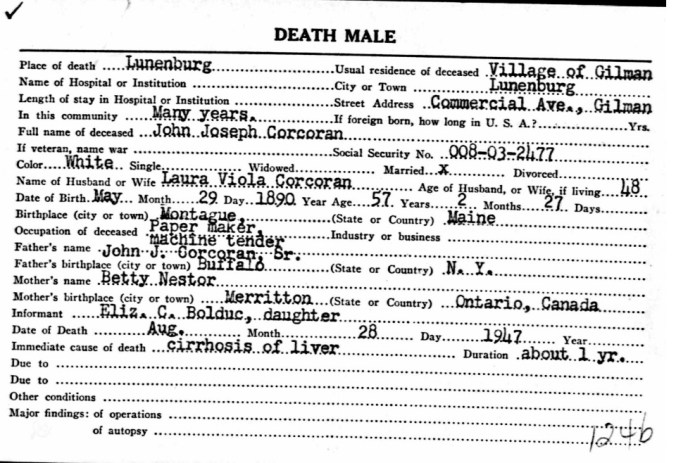A recent eBay purchase has been incredibly fun to research and has yielded some solid and fulfilling results. I purchased a group photo of four US soldiers posing in an American studio immediately following the war. How do we know they are in an American studio? The veteran at center is wearing a WWI Discharge Chevron, also known as a Discharge Stripe or Honorable Discharge Stripe, which indicates that the soldier has been discharged from his service and can wear his uniform in public with the proviso that he affixes the chevron. Apparently, it was possible to be arrested for wearing a service uniform without the stripe after three months following discharge.
A fellow WWI researcher (Brian – AKA WWINERD) posted the following information on a popular militaria web forum:
“Thus far, I’ve been unable to locate any specific General Orders either from the War Department or from the U.S. Army concerning the red discharge chevron, which I believe was adopted early in 1919. However, I do know that:
- Each discharged soldier was issued with three discharge chevrons. Officers had to purchase their own.
- Upon being discharged from service, the uniform could be worn for a maximum of three months without the red discharge chevron.
- If the uniform was worn after the three month period had expired, the person wearing it could be charged with the offense of impersonating a soldier.
- If the uniform was never worn again the discharge chevron did not have to be sewn on.
- As soon as a soldier received his discharge papers he became a civilian, and he was no longer obligated to salute a superior officer.
These and other facts pertaining to the uniform and discharge chevron were explained in a post war pamphlet handed out to Doughboys before they mustered out of the Army. It partially read as follows:
The Uniform
If it is your desire to go home in uniform, it is your privilege to do so, under full grant of an act of Congress. You may wear your issue uniform as long as it hangs together if you wish. It is yours. But do not let a minute pass, after being discharged, until you have sewn on, or had sewn on a red chevron, point up, midway between the elbow and the shoulder on the left sleeve.
The wearing of any gold, silver, or metal device indicating service is forbidden. Only regulation service chevrons and collar insignia are authorized by law and regulations. Wound and service chevrons for service in any of the Allied Armies are included in that authorization. Can all camouflage.
Remember in wearing the uniform, that all of its privileges are yours, with none of the restraints. You are a civilian. There is no law or regulation or tradition requiring you to salute an officer. But so long as the O. D. or the Navy blue or the Marine green covers your body, it should be your pride as one with a military training, and as a soldier who participated in the Great War, to be courteous.”
Where Do We Go from Here: This is the Real Dope, 1919, William Brown Meloney, page 21, 22
Ok – so we know the photo was taken stateside at some point after the war, but recent enough to warrant a group shot of all four men in uniform. The photo trifold mount had “Ward Boys” scribbed on it with no additional identifying information. The seller was from Ohio, so I started with a basic search for Ohio veterans with the last name of Ward. Big mistake……. There were nearly a hundred men with the last name of Ward who served in Ohio during the war. Take a deep breath…..
I needed to narrow down the search and the image itself provides a very good way in which to identify one of the soldiers based on his patches.
See those patches on his left sleeve? They’re from a very famous unit that served in Italy during the war. In fact, this is an incredibly rare shot that depicts a soldier wearing regimental, divisional and army level patches along with the discharge chevron previously mentioned. Ok – so we know one of the Ward Boys was in the 332nd Infantry Regiment. Since the typical US regiment during the war varied between 1000-2000 (roughly), it’s highly unlikely that two men with the last name of Ward were likely to both be from Ohio. Luckily, my research gamble paid off……
Bingo! After interpreting the abbreviated information in the Ohio WWI book, I was able to determine that Clayton was born in Defiance, Ohio, was 24 years of age, and served with Company H of the 332nd Infantry Regiment. With the place of birth info, I was able to identify all the additional men in the photo using clues present on each of their uniforms.
A quick search for the 1910 US census record for the Clayton Ward provided me with the names of his brothers:
With the census in hand, I was able to make out a few names of brothers who were of-age to serve during WWI. Clint (short for Clinton) and Perry were easy enough to research. The same Ohio reference book provided the following:
Based on the information provided in the reference book, Clinton Ward, age 26 1/12 at the time, enlisted with Company G of the 6th Infantry of the Ohio National Guard. This unit was federalized and became Company G of the 147th Infantry Regiment. He rose to the rank of Private First Class on May 15th, 1918. Since I’ve memorized the rank insignia of the AEF, I was able to quick pick him out.
See the round patch on his right arm? That’s the rank insignia worn by a Private 1st Class during WWI. I’m including a generic view of the patch below:
Since he’s the only one wearing a Pvt. 1st Class patch in the photo, plus the addition of infantry regiment collar discs, he’s almost certainly Clinton.
Although it’s tough to make out in the scan, the soldier is clearly wearing a collar disc that depicts a set of crossed cannon. This would indicate service in an artillery unit during the war. Perry’s reference in the aforementioned Ohio WWI book shows that he served with the 52nd Coastal Artillery Company during WWI, which would be supplied with these exact collar discs.
At this point, I’ve been able to identify three of the four soldiers in the photo based on archival research, visual interpretation and identification of key pieces of military insignia, and a gut feeling. The last soldier, shown sitting turned out to be a tough nut to crack.
Ok – so what do we see in the photo?
- A seated male, appearing to be the oldest based on facial details
- A 37th Division patch on the left sleeve
- A discharge chevron and overseas service chevron
- Corporal rank insignia on the right sleeve
- Infantry collar disc
In essence, we have an older-looking corporal from the 37th division who served for at least six months (the service chevron) overseas in an infantry regiment. A detailed search of the Ward’s who served from Ohio in WWI yielded the only possible candidate:
John Alvin Ward was a brother who separated from the family early in life (no idea why) and eventually rose to the rank of corporal in WWI as part of the 147th Infantry Regiment. It was tough to parse out the details regarding his upbringing, but the following Social Security information confirms that he was indeed from the Ward family of Defiance, Ohio.
At first I was confused about the portion mentioning his father being identified as a William H. Ward, but upon further genealogical research it became clear that his father commonly switched his first and middle names; this is a common practice that becomes terribly difficult for researchers.
So, we have the older brother who left the family and posed with his brothers after returning home from war in 1919. Sadly, the photograph was discarded at some point and made it’s way into the eBay chain; eventually ending up on the desk of an intrepid WWI researcher (Me!) who was able to bring some context to the photo using easily-accessible internet resources. I hope I’ve inspired some readers to delve into their own collections of photos in hopes of giving a name to the faces sitting in photo binders and dusty drawers.
Interested in researching Ohio World War One veterans? Check out the following book:
The Official Roster of Ohio Soldiers, Sailors, and Marines in the World War, 1917-18. Columbus, OH, USA: The F.J. Heer Printing Co., 1926.














